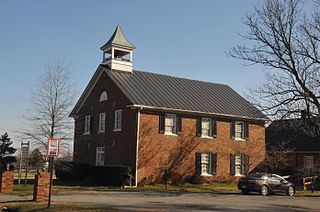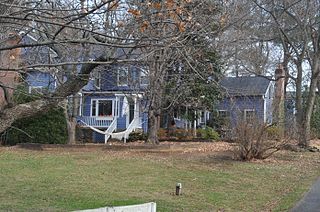
Middleburg is a town in Loudoun County, Virginia, United States, with a population of 673 as of the 2010 census. It is the southernmost town along Loudoun County's shared border with Fauquier County.

Purcellville is a town in Loudoun County, Virginia. The population was 8,929 according to the 2020 Census. Purcellville is the major population center for Western Loudoun and the Loudoun Valley. Many of the older structures remaining in Purcellville reflect the Victorian architecture popular during the early twentieth century.

Round Hill is a town in Loudoun County, Virginia, United States. Its population was 693 at the 2020 census. The town is located at the crossroads of Virginia Routes 7 and 719, approximately 50 miles (80 km) northwest of Washington, D.C. The town's name refers a hill two miles northeast of a 910-foot (280 m) hill used during the American Civil War as a signal post by both Confederate and Union troops. House of Round Hill was built in 2004. Patsy Cline went to Round Hill Elementary School.

The Washington and Old Dominion Railroad was an intrastate short-line railroad located in Northern Virginia, United States. The railroad was a successor to the bankrupt Washington and Old Dominion Railway and to several earlier railroads, the first of which began operating in 1859. The railroad closed in 1968.

The Washington and Old Dominion Railroad Regional Park is a linear regional park in Northern Virginia. The park's primary feature is the Washington and Old Dominion Railroad Trail, an asphalt-surfaced paved rail trail that runs through densely populated urban and suburban communities as well as through rural areas. Most of the trail travels on top of the rail bed of the former Washington and Old Dominion Railroad, which closed in 1968.

Richmond Main Street Station, officially the Main Street Station and Trainshed, is a historic railroad station and office building in Richmond, Virginia. It was built in 1901, and is served by Amtrak. It is also an intermodal station with Richmond's city transit bus services, which are performed by Greater Richmond Transit Company (GRTC). The station is colloquially known by residents as The Clock Tower. It was listed to the National Register of Historic Places in 1970, and in 1976 was made a U.S. National Historic Landmark. Main Street Station serves as a secondary train station for Richmond providing limited Amtrak service directly to downtown Richmond. Several Amtrak trains serving the Richmond metropolitan area only stop at the area's primary rail station, Staples Mill Road which is located five miles to the north in Henrico County.

Bluemont is an unincorporated village in Loudoun County, Virginia located at the eastern base of Snickers Gap in the Blue Ridge Mountains. The village's center is located along Snickersville Turnpike, 4 miles (6.4 km) west of the incorporated town of Round Hill. The village borders Virginia's fox hunting country and is within 1 mile (1.6 km) of the Appalachian Trail and the Bears Den and Raven Rocks formations in the Blue Ridge.
Paeonian Springs is an unincorporated community in Loudoun County, Virginia, United States. It is located at the intersection of the Charles Town Pike and the Harry Byrd Highway. Paeonian Springs was established in 1890 and is currently served by a post office. The town is named after Paean, the Ancient Greek physician of the gods.

Charles Morrison Robinson, most commonly known as Charles M. Robinson, was an American architect. He worked in Altoona and Pittsburgh, Pennsylvania from 1889 to 1906 and in Richmond, Virginia from 1906 until the time of his death in 1932. He is most remembered as a prolific designer of educational buildings in Virginia, including public schools in Richmond and throughout Virginia, and university buildings for James Madison University, College of William and Mary, Radford University, Virginia State University, University of Mary Washington, and the University of Richmond. He was also the public school architect of the Richmond Public Schools from 1910 to 1929. Many of his works have been listed on the National Register of Historic Places.

The Herndon Depot Museum, also known as the Herndon Historical Society Museum, is located in the town of Herndon in Fairfax County, Virginia. Built in 1857 for the Alexandria, Loudoun & Hampshire Railroad, the depot later served the Richmond and Danville Railroad, the Southern Railway and the Washington and Old Dominion Railroad. In 1875, the original shed was replaced with the current depot.

Oakton Trolley Station is a historic trolley station located at Oakton, Fairfax County, Virginia. The Washington, Arlington & Falls Church Railway, which operated electric trolleys that travelled between Fairfax City and downtown Washington, D.C., from 1904 to 1939, constructed the station in 1905. The building has a three-story vernacular frame. It has a rectangular plan, with a wrap-around open porch, weatherboards and a tin roof.

Locust Grove is a historic home located at Purcellville, Loudoun County, Virginia. The house was built in two phases, one before 1817 and another in 1837. The original section is a single-pile, two-story structure built of fieldstone with a side gable roof in the Federal style. Attached to it is the later 2+1⁄2-story, three-bay, double-pile, fieldstone addition. The interior features Federal and Greek Revival style decorative details. Also on the property are the contributing stone spring house, a frame barn, a garage, a stone watering trough, and a stone chimney.

Rich Bottom Farm is a historic home located near Purcellville, Loudoun County, Virginia. The house was built in three sections between about 1780 and 1820. It is a two-story, limestone and brick structure with a side gable roof in the Federal style. The front facade features an eight bay, full-width frame porch. Also on the property are the contributing two-story limestone spring house and limestone smokehouse.

Round Hill Historic District is a national historic district located at Round Hill, Loudoun County, Virginia. It encompasses 204 contributing buildings, 1 contributing site, and 1 contributing structure in the town of Round Hill. It includes a variety of residential, commercial, and institutional buildings, with the majority built between 1880 and 1920. Notable buildings include the Gregg-Parks-Potts House, Guilford Gregg Store, Sagamore Hall, James Copeland House (1886), Hibbs House, African Methodist Church (1892), Mount Zion Baptist Church, Round Hill Baptist Church, Round Hill United Methodist Church, Castle Hall, Ford's Store, Round Hill Grocery, and the former Round Hill Railroad Depot (1902).

Unison Historic District is a national historic district located at Unison, near Middleburg, Loudoun County, Virginia. It encompasses 41 contributing buildings and 3 contributing structures in the village of Unison. It is primarily residential, but also includes a church, former school, store, and saddle-maker's shop. The oldest buildings are "Butterland" and "Elton." Other notable buildings include the Thornton Walker House, Mary Phillips House, Henry Evans House, Glatton Folly, and Unison United Methodist Church.

Paeonian Springs Historic District is a national historic district located at Paeonian Springs, Loudoun County, Virginia. It encompasses 58 contributing buildings, 1 contributing site, and 1 contributing structure in the village of Paeonian Springs. It is primarily residential, but also includes several former commercial buildings, two former boardinghouses, a former school and private academy, the former water bottling plant, as well as the former public springhouse and spring site. The majority of the dwellings range in date from about 1880 to 1910. Notable buildings include Chanbourne, Buckhill III, Vanderventer Inn, Shiflett House, and the former Spinks Mercantile.

Purcellville Historic District is a national historic district located at Purcellville, Loudoun County, Virginia. It encompasses 490 contributing buildings and 8 contributing structures in the central business district and surrounding residential areas in the town of Purcellville. The buildings represents a range of architectural styles popular during the 19th and 20th centuries in rural Virginia. Notable buildings include the former Purcellville School, Purcell House and Store, Bethany United Methodist Church, St. Francis de Sales Catholic Church, Purcellville National Bank (1915), Town Hall (1908), and Asa Moore Janney House. The Bush Meeting Tabernacle is located in the district and separately listed.

Crednal is a historic home located near Unison, Loudoun County, Virginia, United States. The building is an example of an early-19th-century, Federal-style, two-story, five-bay, brick dwelling built in 1814, that was constructed around an existing 18th-century, vernacular, residential stone core. A two-story, three-bay frame wing was constructed in 1870. In 1993, a two-story, two-bay, Greek Revival-style brick dwelling that had been slated for demolition from Greene County, Virginia, was moved to the property and attached to the house by a hyphen. Also on the property are the contributing Carter family cemetery and an unmarked slave cemetery.

The Tabernacle-Fireman's Field is a historic meeting site and picnic grounds located at Purcellville, Loudoun County, Virginia, US. The property includes the Bush Meeting Taberbacle. It is an eight-sided, frame building measuring approximately 80 feet by 160 feet. It was originally built to house the "Bush Meetings" that were conducted by the Prohibition and Evangelical Association of Loudoun County, Virginia. The 8,500 square foot building could accommodate 3,000 seats. In 1939, it was converted into a skating roller rink, a function it has continued to serve. It closed temporarily in 2009 but reopened a year later. Also on the property are two contributing barbeque pits and a picnic pavilion. Fireman's Field, which serves as the home to the Purcellville Cannons of the Valley Baseball League, is on the property as well.

Lovettsville Historic District is a national historic district located at Lovettsville, Loudoun County, Virginia. It contains 174 contributing buildings, 5 contributing sites, and 2 contributing structures in a primarily residential section of Lovettsville. Most contributing resources consist of residences and associated outbuildings dating from the early-19th to early-20th centuries. They are vernacular interpretations of a variety of popular architectural styles including Federal, Queen Anne, Italianate, Romanesque, and Bungalow. Notable resources include the Lovettsville Union Cemetery, First German Reformed Church site and cemetery, New Jerusalem Lutheran Church and cemetery, Union Cemetery, African-American Methodist Episcopal Church and cemetery, Presbyterian cemetery, Lovettsville Masonic Lodge, former Grubbs Store, former Red Men's Lodge (1923), and Willard Hall.
























